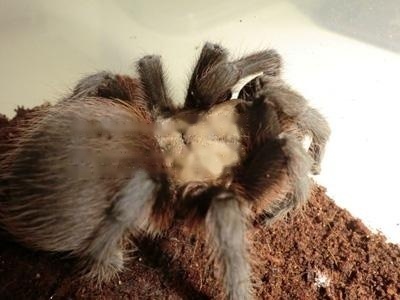
Texas Brown Tarantula
Adult body length is 13-14 cm, suitable temperature is 28-30 ℃, and suitable humidity is 65%. It is recommended to use moist peat, coconut brick and clay as the substrate. It tak
feather-tailedCentipede (Latin name: Alipes grandidieri) is native to the tropical rain forests of West Africa and Tanzania. It is a large and highly toxic centipede with a maximum body length of 20 centimeter. Its special feathery tail feet (also called trolling feet, which are sensory organs) are brightly colored and peculiar. When encountering an enemy, you can even make a threatening sound of "click and click", the rhythm is the same as the tail Like snakes, breeders who hear this sound for the first time must be both familiar and surprised. Hence another name was born: "Rattle Centipede".
Feather-tailed centipedes are relatively easy to raise. Use a rectangular transparent plastic box with good airtightness, pierce a few small ventilation holes, and use wet soil (small particles) for reptiles as the substrate. Fine sand, because it has the habit of drilling soil, so the thickness of the substrate should be more than 3 cm. The suitable temperature is 24~28℃, and the suitable humidity is 70%~80%. The feather-tailed centipede needs high humidity, and it will also feed on the water droplets splashed on the four walls when spraying water. The larval growth stage should be fed once every 2 to 3 days, and the food is small insects, small bees, mealworms, mealworm pupae, needle crickets, etc.; the adult stage should be fed once a week, and the food should be varied. After eating, take out food residues in time to avoid rapid corruption and pollution of the environment under high temperature and high humidity conditions.
Also note that it must be picked up with tweezers or chopsticks, and must not be used. Feather-tailed centipedes are ferocious, neurotic, and move quickly, and will suddenly attack or escape. Be sure to check whether the lid is closed every day. If it is kept in a shallow box, it will be easy to escape. You can use a large box to buckle or use a net to catch it.
Chinese name: Feather-tailed centipede
Latin name: Alipes grandidieri
Kingdom: Animalia
phylum: Arthropoda
Class: Myriapoda
Distribution area: Tanzania, western African continent
When encountering an enemy, it can make a threatening sound of "click, click, click", and the rhythm is the same as the rattle Snake, the breeder who hears this sound for the first time must be It is both familiar and surprising. Hence his other name was born: "Rattle Centipede".
Physical characteristics: The body is 9-12cm long, and its special feathery tail foot (also called the drag foot, which is a sensory organ) is not only brightly colored but also unique.
Diet: Feeds on insects
Other: Alipes grandidieri is Centipede a super popular species among fans , its special feathery tail feet (also known as trolling feet, which are sensory organs) are not only brightly colored and peculiar (because they sound very similar to rattlesnakes).
feather-tailedThe centipede is relatively easy to raise, with a maximum body length of 20 cm. Its special feathery tail feet (also called trolling feet, which are sensory organs) are brightly colored and peculiar. Hence another name was born: "Rattle Centipede". Feeding method, use a rectangular transparent plastic box with good airtightness, tie a few small ventilation holes, and use wet soil (small particles) for reptiles as the substrate with a little fine sand. Because of its habit of drilling soil, the thickness of the substrate is To be more than 3 cm. The suitable temperature is 24~28℃, and the suitable humidity is 70%~80%. The feather-tailed centipede needs high humidity, and it will also feed on the water droplets splashed on the four walls when spraying water. The larval growth stage should be fed once every 2 to 3 days, and the food is small insects, small bees, mealworms, mealworm pupae, needle crickets, etc.; the adult stage should be fed once a week, and the food should be varied. After eating, take out food residues in time to avoid rapid corruption and pollution of the environment under high temperature and high humidity conditions.
Also note that it must be picked up with tweezers or chopsticks, and must not be used. Feather-tailed centipedes are ferocious, neurotic, and move quickly, and will suddenly attack or escape. Be sure to check whether the lid is closed every day. If it is kept in a shallow box, it will be easy to escape. You can use a large box to buckle or use a net to catch it.